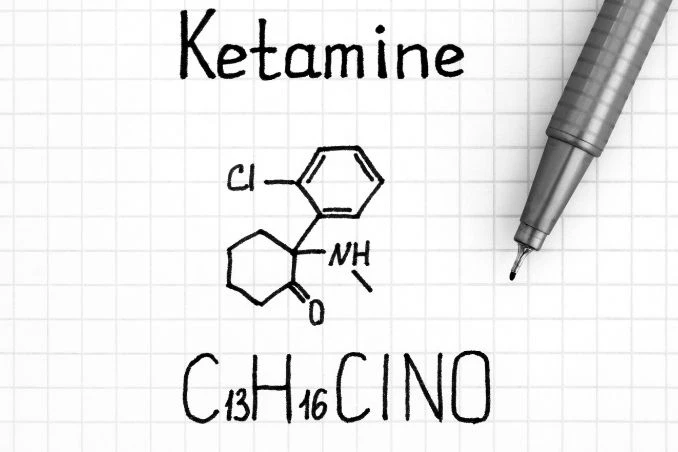The Risks and Realities of Using Ketamine
Table of Contents
- The Risks and Realities of Using Ketamine
- Is Using Ketamine Dangerous?
- Off-Label Use of Ketamine
- What Are the Effects of Ketamine?
- How Do People Use Ketamine?
- How Does Ketamine Work?
- Signs of Ketamine Abuse
- The Risks of Ketamine
- Can You Overdose from Special K?
- Is Ketamine Addictive?
- What are the Signs of Ketamine Addiction?
- Getting Help for Ketamine Dependence
- Recovery for Ketamine Users is Possible
- Medically Reviewed By
Ketamine, also sold under the brand name Ketalar, is a dissociative anesthetic. Doctors use it as a general anesthetic either on its own or with other general anesthetics including nitrous oxide.
Ketamine is often used for procedures that require short-term sedation and don’t require muscle relaxation. These include treating wounds in uncooperative patients such as children and fixing joint dislocations and fractures. Ketamine is also used as an animal tranquilizer in veterinary practices.
Is Using Ketamine Dangerous?
When abused, it can cause hallucinations similar to those produced by LSD and PCP. Like many other drugs that cause psychoactive effects, ketamine is often misused. Street names for ketamine include:
- Special K
- Cat tranquilizer
- Kit Kat
- Jet K
- Super acid
- Vitamin K
- Cat valium
- Purple
- Special La Coke
- Super K
When used in medical settings, ketamine is typically in the form of a clear liquid. However, the product sold on the street is usually a grainy white powder or a brown crystalline powder. There are also ketamine tablets available but they aren’t as popular.
Off-Label Use of Ketamine
Ketamine is categorized as a Schedule III non-narcotic by the Food and Drug Administration. It is only approved for use as an anesthetic but some doctors prescribe it for “off-label” uses. This means they use the drug in ways that are not approved by the FDA.
More specifically, ketamine is often used as a treatment for major depression because it may rapidly reduce serious symptoms of depression including suicidal thoughts and actions. It may also be helpful in treating individuals who have both depression and anxiety. People who support the use of ketamine to treat depression say it works a lot faster than other treatments.
What Are the Effects of Ketamine?
Some people who don’t have prescriptions for ketamine source it on the street because of its hallucinogenic properties. While it’s safe to use this drug in a controlled medical setting, the recreational use of ketamine is dangerous. There are many risks and serious side effects associated with recreational ketamine use.
As noted previously, ketamine is a dissociative drug. What are disassociatives? These are drugs that cause detachment in users. A person may feel detached from themselves and identity (depersonalization) or from things and people around them (derealization).
This effect, along with ketamine’s ability to reduce pain, causes people to use it inappropriately. Recreational users say they feel like they’re separated from their bodies or floating. Some people also report sensory detachment that’s so extensive that they consider it a near-death experience.
Recreational ketamine use is popular among teenagers and young adults who attend nightclubs and parties. Some prefer ketamine over PCP or LSD because the hallucinations last for 30 minutes to an hour rather than several hours.
Ketamine is also used as a date-rape drug because it can cause sedation, incapacitation, and short-term memory loss. Perpetrators often slip into victims’ drinks. Since it has no taste or smell, the victim won’t know their drink has been tampered with.
How Do People Use Ketamine?
Individuals typically use recreational ketamine in one of four ways. Most people who use the powder snort it. Snorting a drug facilitates quick passage through the mucus membranes of the nose into the blood.
The user experiences a fast onset of the drug’s effects and the rush is different from if they had swallowed it. This increases the likelihood of addiction and overdose. Snorting can also cause severe damage to the nasal passages.
Regular users may inject ketamine intramuscularly to get more intense effects. Some users also swallow the power wrapped in cigarette paper. It is less common for individuals to swallow ketamine in tablet form but it does happen.
The way in which ketamine is used plays a determining role in the length of time it takes for users to feel the effects. When taken orally, ketamine usually starts producing hallucinogenic effects in 5 to 30 minutes.
When it is snorted, the effects kick in in 3 to 15 minutes. However, if a person injects ketamine, it may take less than three minutes to start working since it goes directly into the bloodstream.
How Does Ketamine Work?
Scientists aren’t sure exactly how ketamine works. However, it is known that it affects multiple receptors and pathways in the brain and the body. One pathway that may be involved is the glutamate pathway.
Ketamine is an NMDA receptor antagonist so it binds to the NMDA receptor protein on cell membranes and prevents glutamate from binding to them. Ketamine also acts on the mTOR pathway and the AMPA and opioid receptors in the brain.
Signs of Ketamine Abuse
Unlike other drugs, ketamine is very short-acting. However, you can still notice signs that an individual is misusing it. Individuals who are under the influence of ketamine may not react to painful stimuli as expected since the drug blocks pain.
Ketamine also slows people down and makes their movements exaggerated. Therefore, a person who is on ketamine may appear to be walking in slow motion and they may slur their speech and seem confused.
Often, the signs of ketamine abuse are quite similar to the symptoms of alcohol abuse. They may include:
- Nausea and vomiting
- Slowed or difficult breathing
- Hallucinations
- Mood changes
- Impaired ability to think
- Impaired memory
- Disorientation
- Depression
If you suspect a loved one is abusing ketamine, you should be on the lookout for items associated with ketamine use such as pill packets, needles, and empty bottles.
The Risks of Ketamine
Ketamine can cause both mental and physical harm when it is abused. It increases heart rate and blood pressure. Since it reduces pain, paralyzes the muscles, and causes the user to lose touch with reality, individuals can hurt themselves or become vulnerable to being hurt by others.
People who have taken ketamine can also injure themselves without knowing or remembering how they did it.
Ketamine is especially dangerous and potentially fatal when mixed with alcohol, opioids/opiates like heroin, or other depressants. This can lead to respiratory depression which can be potentially fatal. Also, when the individual is temporarily paralyzed, they won’t be able to clear their airways. This can lead to choking and even death as a result of aspiration.
In addition to these short-term effects, ketamine can result in serious bladder problems including urgent, frequent, and painful urination. The urine may also contain blood. Stopping the use of ketamine can help to relieve these problems but sometimes, the damage is so severe that the bladder has to be surgically repaired or even removed.
Liver damage may also result from regular, heavy use of ketamine. In addition, people who take ketamine for a long time may experience abdominal pain which some people refer to as “K cramps”.
Regular ketamine use can worsen mental health issues and result in depression and psychotic symptoms in some cases. Long-term ketamine use can also lead to memory loss, difficulty concentrating, and flashbacks.
Can You Overdose from Special K?
The possibility of overdose is another risk associated with using ketamine recreationally. Individuals who overdose on ketamine are at higher risk of accident and injury because their alertness becomes severely impaired.
The physical effects of large doses can also lead to death. If you believe someone has overdosed on ketamine, you need to call 911. Signs of ketamine overdose include:
- Rapid heartbeat
- High blood pressure
- Loss of consciousness
- Convulsions
- Inability to move
Is Ketamine Addictive?
Not everyone who abuses ketamine will become addicted. This drug doesn’t appear to have as high a risk of addiction as other commonly misused drugs such as heroin and cocaine. However, this doesn’t mean that a person can’t become addicted to it.
Not a lot is known about the addictive potential of hallucinogenic drugs except LSD. However, based on ketamine’s categorization as a Schedule III drug, abuse could result in moderate or low physical dependence or high psychological dependence.
Individuals may develop a tolerance to ketamine, meaning they need to take higher doses to get the same effects. This may lead to dependence and addiction. Ketamine addiction can take over an individual’s life. Therefore, it’s important that they get professional help in regaining control.
What are the Signs of Ketamine Addiction?
One of the main signs of addiction to any substance is continued use even in the face of negative consequences. Individuals who are addicted to ketamine can’t stop using it even when they want to. Signs of addiction include:
- Using more ketamine than intended
- Using ketamine for longer than intended
- Unsuccessfully trying to stop using ketamine or reduce your usage on several occasions
- Need more and more ketamine to get the effects you once did
- Replacing hobbies or social activities with ketamine use
- Stealing or illegally obtaining ketamine
- Feeling invincible or oblivious to the world while using ketamine
- Getting angry or feeling guilty when asked about your drug use
- Neglecting work, school, or home responsibilities.
- Spending a lot of time obtaining, using, or recovering from using ketamine
Getting Help for Ketamine Dependence
Some ketamine users experience physical withdrawal when they stop using. Those in the LGBTQ community and/or the rave subculture who have ritually consumed the substance and have accumulated it within their systems can expect more severe withdrawal effects. The symptoms are often quite like bad flu and they last for four to six days after the last use. Ketamine withdrawal symptoms include:
- Tiredness
- Involuntary eye movements
- Dilated pupils
- Stiff movements
- Chills
- Sweating
Individuals are also likely to experience ketamine cravings, nightmares, depression, and anxiety. Both the physical and psychological effects are unpleasant. However, they can be managed with proper medical care. People who undergo supervised medical detox are monitored during the withdrawal process to ensure they’re safe and comfortable.
Quitting cold turkey is strongly discouraged since it can lead to relapse or life-threatening overdose. Some people find the withdrawal symptoms so uncomfortable that they use ketamine again to find relief.
This starts the process all over again. If you or someone you know wants to stop using ketamine, you should do so with the help of addiction professionals who can wean you off the drug safely and help you to manage your withdrawal symptoms.
Medically-Supervised Detox
People who are addicted to ketamine can get on a path to recovery by enrolling in a licensed treatment facility. The process usually starts with detoxification to rid the body of ketamine and any other substances and prepare the mind and body for further treatment. Detox usually lasts for three to ten days but it can be longer if necessary.
During this time, patients are monitored around the clock and the dosage of ketamine may be tapered off gradually over a set period to help the body adjust to not having the drug. Individuals may also be tested to see if they need to be treated for other illnesses such as diabetes and high blood pressure.
When detox is completed, individuals are evaluated for admission into a rehab program. Staff may ask about details about their ketamine use and whether they use any other addictive substances. The assessment may also help to determine if the person has co-occurring mental health conditions along with their substance use disorder.
It’s not uncommon for people who are addicted to ketamine to show signs of bipolar disorder, post-traumatic stress disorder, anxiety, depression, and other mental health disorders. Once these conditions are diagnosed, the individual will be able to get a treatment plan that’s tailored specifically to their needs.
Rehabilitation
Treatment programs can take several forms. People with severe addictions need inpatient care. This is where individuals reside in a rehab facility for a set period and receive intensive treatment. These programs often run for one to three months and they include various therapies.
In many cases, patients benefit from cognitive-behavioral therapy. This helps them to identify distorted and harmful patterns of thought and behavior and replace them with improved coping strategies. They gain insight into what led to their ketamine use and learn how to avoid addictive substances.
Treatment for ketamine addiction can also include individual, family, and group counseling; 12-step programs, and complementary therapies such as art and music therapy. People who have a mild addiction or are in the early stages of addiction may be able to receive outpatient care. This allows them to participate in treatment sessions and then return home at the end of the day.
Even after formal treatment is over, it’s recommended that individuals take advantage of aftercare services to help reduce their chances of relapse. This may take the form of individual or group therapy or peer support groups. Aftercare is especially important for people who are experiencing post-acute withdrawal symptoms.
Ketamine users who develop PAWS may struggle with anxiety, depression, irritability, and cognitive impairment long after dependence ends. It’s important to note that some people need to attend rehab more than once before they achieve long-term sobriety.
Recovery for Ketamine Users is Possible
Many people find it hard to seek treatment for ketamine dependence or addiction. However, professional help is necessary if you or someone close to you is struggling to stop using ketamine. You shouldn’t be afraid or embarrassed to seek help. There are numerous addiction treatment centers in the United States and there’s at least one that will meet your needs.
Finding the right program can be difficult especially when you’re in the grips of addiction and struggling to think clearly. However, you shouldn’t let that deter you. Find Addiction Rehabs can assist you in finding a rehab facility that offers the environment and services you need.
We help individuals and their families narrow down their options and begin the process of healing. Our highly trained staff can connect you with a wide range of facilities that offer medically supervised detox, inpatient care, partial hospitalization, and outpatient programs.
All we ask is that you fill out the contact form on our website or call us at 877-537-1481 at any time of the day or night to find out which facilities are suitable for your needs. In some cases, we can facilitate placement within 24 hours. There’s no need to try to manage your ketamine addiction on your own. Contact us today to get the help you need and deserve.
Brandon is a highly skilled content writer and behavioral health marketer with over a decade of experience. In his own words: in my work with Find Addiction Rehabs, I have dedicated my expertise to a cause close to my heart – substance abuse recovery. Through my passion for the field, I’ve successfully compiled a track record of crafting compelling content that educates, inspires, and supports those on their recovery journeys.



